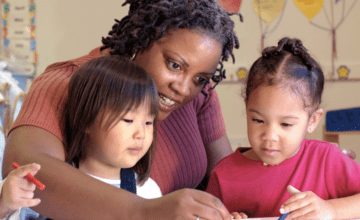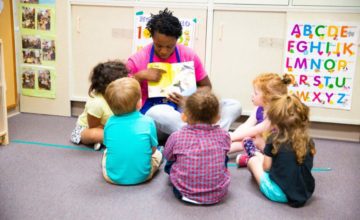By Rebecca Parlakian and Claire Lerner
Welcome to the world of talking toddlers—you can never guess what they’ll say next! Browse the information and links below to see what your little one is experiencing and learning this month.
What It’s Like for You
Marisa, mother of Stefan, age 22 months, writes:

Yesterday we were at the park and Stefan started pointing at every man and saying Dada. I kept saying, No, that’s not your daddy. Your daddy is at home. But he kept it up and it was kind of embarrassing. Is he really confused about who his dad is? What’s going on?
Welcome to the world of talking toddlers—you can never guess what they’ll say next! As you’re finding out, toddlers are learning language so rapidly during this period that they often make some interesting mistakes. One is called over-generalizing, which is when your child takes one “rule” (daddy = grown-up man) and applies it to everyone who meets those criteria. But rest assured, your child knows the difference between his daddy and other men. And while every male may now be “Dad,” this stage won’t last for long. The process of sorting and labeling people and objects shows that your child is making great strides in his thinking skills. He is also getting much better at communicating his ideas using language. That’s a big step for a little guy. So when your child calls the mail carrier “daddy,” you can simply say, That’s the person who brings our mail. He’s a man and he might be a daddy, too. Over time and with experience, your child will learn the words he needs to accurately label what he sees.
What It’s Like for Your Child

I try to put the big whiffle ball on the tee, but it keeps falling off. So I walk after it, grab it, and try to get it up there again. It takes a few tries, but finally the ball stays on top of the tee. Then Uncle Martin hands me a bat. I take it and stand in front of the tee. The first time I swing it, I completely miss the ball! What happened? Uncle Martin says, Good effort! Try again. So I stand back and swing, and whack! I knock the ball off the tee! Uncle Martin claps and shouts. I run to find the ball in the grass and put it on the tee again. It’s fun playing this game over and over. I feel so good when I can hit the ball all on my own!
Then my cousin Deneisha comes over. She wants a turn. I’m not too happy about sharing my ball or bat. Uncle Martin says, Deneisha is on your team. Everyone gets a turn to hit the ball. Why don’t you put the ball on the tee and let Deneisha hit it? Then you can have a turn to hit it yourself. He gently takes the bat out of my hands and gives it to my cousin. I’m mad. I don’t want to take turns. I won’t put the ball on the tee and instead I throw it on the ground. Uncle Martin picks up the ball and tells me he knows it’s hard to share but everyone has to have a turn. Then he puts the ball on the tee. Deneisha hits it and gives me back the bat. That wasn’t too long to wait. We play and take turns for long time while Uncle Martin watches. Deneisha is so fun to play with!
What Your Toddler Is Learning
Social-Emotional Skills:
- Persistence as he keeps working toward his goal of trying to get the ball to stay on the tee.
- Confidence that he can do what he sets out to achieve—set the ball on the tee and hit it
- Relationship-building skills as he enjoys time playing and talking with * * Uncle Martin
- Cooperation as he learns to accept limits and to take turns playing ball with his cousin
- Friendship-building skills as he enjoys playing with his cousin
Language and Thinking Skills:
- How language is used to communicate limits, as when Uncle Martin explains how the children will take turns
- How objects work as he figures out how and where to swing the bat so that it hits the ball
- Motor-planning skills—taking a series of steps to reach a goal—as he sets up the ball on the tee and figures out how to hit it successfully
- Event sequences, such as Scenario #1: I put the ball on the tee, hit it, retrieve it and begin again; and Scenario #2: I hit the ball, then Deneisha hits it, then I get to hit it again.
Physical Skills:
- Fine motor skills—using the small muscles in his hands and fingers as he balances the ball on the tee
- Large motor skills—using the larger muscles in his arms and legs as he swings the bat and runs after the ball
What to Expect From Your Toddler’s Development
As you read the chart below, keep in mind that development is not a race and that every child grows at her own pace and in her own way. Your child may develop skills faster or slower than indicated below and still be on track. If you have questions or concerns, talk with your child’s health care provider or other trusted professional.
Your Toddler’s Development From 18 to 24 Months
| What Your Baby Can Do | What You Can Do to Connect With Your Baby |
|---|---|
I am learning new words everyday. |
|
|
|
I can use my hands and fingers to do so many new things. |
|
|
|
I am learning about my own and others’ feelings. |
|
|
|
I am beginning to use my imagination. |
|
|
|
I am a little scientist, always testing things out! |
|
|
|
Did You Know…
Your child is starting to understand new ideas by using his thinking skills and imagination? Researchers gave a group of 22-month-olds and 19-month-olds a stuffed animal to play with in the laboratory. The researchers then took the toy out of the room and told the toddlers that it had gotten soaking wet after someone spilled a bucket of water on it. They asked children to go into the next room and find the toy. The researchers were looking to see if the toddlers would take the wet stuffed toy, or the dry one. The 22-month-olds (but not 19-month-olds) correctly selected the wet toy. This shows that by 22 months, toddlers were able to use the new knowledge they received to change their mental image of the toy from dry to wet. Using their imaginations, they were able to picture what a “soaking wet” stuffed animal might look like, which helped them pick the right one. This represents a huge leap in thinking skills as children are now able to use their mind to think about new ideas and concepts.
What the Research Means For You
You can nurture your child’s critical new thinking skills just by talking together about everyday events. You might explain that when there are a lot of gray clouds in the sky it means that rain may be coming soon; that cars need gasoline in order to go; and, that medicine (while it tastes yucky) will actually make his body feel better. Talking with you about daily events and experiences is one of the most important ways that your child begins to understand new ideas and concepts.
Spotlight on: Making the Most of Your Child’s “Language Explosion”

Talk to a few toddlers and you’ll hear some interesting words—carker for “cracker,” pilyo for “pillow,” aminal for “animal,” cool for “school.” Keep in mind that incorrect pronunciations are not only normal and expected, they are actually a good sign that your child is listening and learning new words and trying them out. This shows that she’s an active, confident learner.
Your child’s ability to pronounce words correctly will develop over time. By the time your child is 3, adults outside your family should be able to understand her. For now, close family, friends, and caregivers will likely understand her words most of the time—but not always. However, adults who don’t spend a lot of time with your child may have a little trouble understanding what she’s saying. Some common errors you may hear include:
- Shortening words, saying duh for dog or ju for juice.
- Leaving out letters, saying poon for spoon.
- Replacing letters. Consonants that are difficult to pronounce, like k or t, may be replaced by easier-to-pronounce consonants. Truck may be pronounced guck.
- Applying one grammar rule very broadly (known as over-generalizing).
Toddlers frequently use one word to convey many meanings. Your child might say dog to describe any furry animal on four legs.
Notice how hard your toddler is trying to communicate by using words in whatever way she can to get her message out. For most kids, these language “kinks” work themselves out over time, as your child hears more and speaks more herself. Until then, try some of the strategies below to nurture her language development during this period of rapid speech development.
What You Can Do:
See the silver lining in speech mistakes. Constant corrections can make your child less confident about speaking. Instead, look at mistakes as a step forward. When you hear an error, model the correct pronunciation in your response. If you child says, Gamma said I could have a cookie, you might respond by saying, I see that Grandma gave you a cookie, yum yum! This gives your child a chance to hear how the word sounds. It also shows your child how talking is a pleasurable back-and-forth process.
Be a translator. If other adults have difficulty understanding your child’s speech, you can “translate” what he is saying. Give your child a chance to speak first, and then explain: Julio is telling you that this is his new truck.
Repeat it—again and again. Choose books and songs that repeat words or phrases. Children learn new words and pronunciations through repetition. One good choice for this age group is Brown Bear, Brown Bear What Do You See? by Eric Carle. Other good choices include books that:
- Encourage a response from the child, such as books that pose simple questions like Where Is Baby’s Belly Button by Karen Katz or Pat the Bunny by Dorothy Kunhardt;
- Provide clear pictures of common objects (you can name the pictures for your child);
- Explain daily routines like getting ready for the day, going to the doctor, or getting ready for bed; or
- Offer predictable plots that toddlers can understand through the pictures.
Let’s Play: Activities That Nurture Bonding and Learning
Let’s sort things out

Toddlers love to sort. This new skill, called categorization, is really building around this time. Line up a group of your child’s favorite toys—cars, trains, plastic animals, balls, toy dishes. Then ask your child, Can you find all the toys with wheels? Can you find all the animals? See if your child would like to ask you to find a certain type of toy. You can even sort items as you do chores—ask your child to put socks in one pile and shirts in another while you’re doing laundry, or put crackers on one side of the plate and cheese slices on the other for a snack.
Color me happy
Fill several clear plastic bowls with water that you tint with food coloring. Give your toddler cups and spoons to pour and stir the water. Notice with your child how the colors change when you mix them. As with any activity involving water, supervise your child carefully and empty water from all containers when you are through playing.
What’s on Your Mind?

1. It is impossible to grocery shop with my 22-month-old. She wants to grab for everything and struggles to get out of the cart…help!! What can I do?
One option it to simply leave her home. But for most of us, this is simply not possible. Fortunately, the grocery store can be a very rich learning experience for your child. That’s why in many children’s museums, preschool classrooms and child care centers you see a pretend grocery store as one of the learning centers.
Start with some preventative measures you can take to minimize the need for lots of “NO!”s.
First, try to do your bigger shopping trips without her, if possible. While you’re out loading up on groceries this can be an opportunity for her to have special, one-on-one time with your partner, grandparents, or other family or close friends. Or switch off on babysitting with a friend who has children the same age as yours. You can watch her kids while she shops, and vice versa.
Have your child choose one or two toys or books she can take with her to distract her while you shop. Talk with her about what she’s “reading” or doing while you shop.
Bring a few snacks. Just like for us adults, it is hard for children to resist wanting to eat all the yummy food staring at them aisle after aisle. Or, let her choose one item from the shelves that doesn’t have to be washed or weighed that she can eat while shopping.
Here are some strategies you can use to make grocery shopping fun for your child (while also helping her learn as you go):
- When she’s reaching out to grab, if it’s something she can’t damage (like a box of rice), hand it to her. Talk to her about what it is, what it’s used for, the color of the box, etc.
- Engage her in counting the number of potatoes, cucumbers, and apples that you are picking and hold the bag while she puts them in. The more you actively include her, the more she will learn and the less she will likely fuss.
- Talk to her about all the colors you see and ask her what colors she recognizes. Teach her about big and small as you compare the size of the oranges. She can learn about high and low, and up and down as you point out where different items are on the shelves.
- If you are up for it, let your child out of the cart and get her engaged in some games. (If she’s having fun, she is less likely to run wild!) Ask her to find something on the shelf that you have at home. Have her find her favorite cereal or the one with the sun on the box. See if she can find your brand of milk. These are great ways to build memory skills and to build self-confidence as she finds the right object.
- Have her help you place the items on the conveyor belt with lots of supervision of course. Count the items together.
- Take every opportunity to comment on how helpful she is being. Kids love to contribute. It makes them feel important and builds self-esteem.
Shopping this way does require a lot of energy and patience, and may make your trip to the store longer. But keep in mind that research shows that when children learn concepts through everyday, hands-on experiences, they are able to understand the concepts more easily and the learning is more meaningful.

2. My 22-month-old always wants to be carried, but now she’s getting too heavy to be constantly in my arms. She’ll often throw a tantrum until I pick her up. What can I do?
Ah… the “I want up” syndrome—demanding to be carried 24/7. This is not uncommon. The key is to figure out why she wants to be carried all the time, which requires some detective work.
It may have to do with her developmental stage. Even positive changes bring challenges. Often when children make a developmental leap, such as starting to walk, being potty trained, or beginning preschool, they experience some sort of regression—backward movement in their behavior. While your big girl may be quite proud of her new independence, it can also feel scary to be so separate from you whom she has been dependent on for so long. This can lead to increased clinging and I want up! demands.
It is also important to look at what else is going on in her world that might be making her feel less secure. Is there a new baby in the house? A recent move from crib to bed? A new babysitter or child care provider? Life changes can lead to a period of insecurity until she sees that despite the change, her world is still a safe place to be.
What to do? While you want to continue supporting her growing independence, it’s also important to address her underlying need for support and reassurance. This means creating opportunities to spend more one-on-one time together. Give her extra cuddles throughout the day. Cozy up on the couch to read books for a little longer than usual. Spend a few extra minutes bonding at bedtime.
To encourage walking, first validate her feelings and then offer an alternative: I know that you want Mommy to carry you, but I can’t right now. What I can do is hold your hand. Encourage her by connecting walking with her own goals: Walking will help make you a faster runner on the playground! Tell her how proud you are when she uses her “walking feet.” You can help her slowly adapt, for example, by offering to carry her from the car to the mall, rather than throughout the entire shopping trip. Finally, you can offer her the stroller. Many toddlers go back to strollers for a while until they decide on their own that they’re too big for that.
With some extra nurturing and gentle encouragement, she will work through this phase and make the transition to walking as a regular form of travel. Best of all, she’ll have developed some important new skills—emotional and physical—that will help her be more resilient and confident as she continues to grow and change through her toddler years.
Expert Reviewers
- Terrie Rose, PhD, President and Founder, Baby’s Space
- Ross Thompson, PhD, Professor of Psychology, University of California at Davis
- Robert Weigand, MS, IMH-E, Director, Child Development Laboratory, Arizona State University




